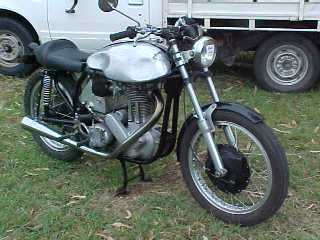
The push-rod Manx at the Esk 2002 Rally
The push-rod Manx
Penned by Paul Reed - HMCCQ Brisbane

The push-rod Manx at
the Esk 2002 Rally
The project was to turn a
very mundane, overweight and underpowered, 1962 350 Model 50
Norton, into Norton's answer to the Thruxton and Gold Star.
(Well, not quite.)
The first step was to increase its capacity to 500cc, by using a
BMW R80GS barrel and piston, giving it a bore and stroke 0f 85 x
88, instead of 71 x 88. This was not difficult to do, just a
matter of plugging up the holes for the through bolts and
re-drilling them, re-sizing the gudgeon bush to suit the BMW
gudgeon, and making a spacer for the cylinder base to get the
piston height correct. The alloy BMW barrel also saved many
pounds in weight compared to the cast-iron original. The cylinder
head was not altered, the original carburettor and inlet valve
were retained, (giving a wide squish-band) as I was not looking
for peak power at high revs, just good solid mid-range
performance.
With this in mind, Ivan Tighe advised against re-grinding the
cams, as the Model 50 cams are already a bit sharper than ES2
cams, to try to compensate for the excess weight, I suppose.
Next, I did away with the alternator and shortened the crankshaft
to suit. As the Model 50 had coil ignition, I replaced the
contact breakers with a flange-mounted Lucas magneto, ex
Velocette, but fitted with manual advance. I had a fire sale,
disposing of all original tin-ware (it weighed a ton), and the
wheels, exhaust system, footrests, brake pedal, handlebars,
headlamp, fork covers, tanks, everything went. I was now
committed.
I bought a pair of Triumph conical hubs for $100 each,
reconditioned them, and spoked them into flanged alloy rims. I
ordered, from England, alloy petrol and oil tanks, the latter
with a battery compartment, a set of Unity rear-sets, a Manx
primary chain guard, and a Manx seat. Also a Scitsu electronic
tachometer, and a pair of Tingate clip-ons.
It was then just a matter of bolting it all together. The tricky
bits were getting the rear wheel and chain alignment right, and
working out how to anchor the front brake. I made an engine
sprocket from an old BSA A7 one, to give a 4.2 top gear for easy
cruising.
In this form, it had potential, but was far from right. With the
light 250 flywheels and big engine sprocket, it was hard to
generate enough momentum to kick it over its 8.5 to 1
compression, with my puny 60 kg. The standard AMC gears were too
wide, and while it accelerated well, and reved smoothly, it would
not happily pull the 4.2 top gear. The dry weight was just over
300 pounds.
I was determined not to settle for a lower top gear, so the
options were to increase the flywheel weight and the engine
capacity, and try for closer internal ratios. A pair of ES2
flywheels (100mm stroke) increased both the capacity, to 565cc,
and the flywheel weight, making it easier to start. This also
necessitated using a shorter con-rod. I also fitted close ratio
gears from a pre-war International, giving ratios of 1, 1.1,
1.33, and 2.33. It would now pull the 4.2 top gear with ease, and
the top 3 ratios were a joy to use, but the low first gear was a
pain, and the motor was nowhere as smooth as before. You fix one
thing, but introduce another problem.
After experimenting with the balance factors, I finished up
discarding the heavy BMW piston, with its low gudgeon, and
machined up a BSA semi-finished piston which Dave Dettmar gave
me. It required some accurate machining to replicate the
cam-grind and taper of the BMW piston, but I felt that this was
would be essential with the BMW plated bore.
After all this, it still vibrated, with a heavy B50 gudgeon pin.
It was slightly better with a lighter B33 pin, so I knew I was on
the right track and obtained a much lighter, tapered (internally)
Gold Star gudgeon pin. This has finally given me an acceptably
smooth motor, but don't ask me the balance factor, I started off
with 65%. The final improvement was to import from Ken McIntosh,
a pair of "Daytona" first gears, giving a 2.00 to 1
ratio, the highest you can use with a kick starter. There is
still a bit of a jump from first to second, which can catch you
out at times, but it is much better than the Inter first gear. I
also found that the clip-ons gave me a sore back, so I shelved
them in favour of a normal set of bars, with extenders. The long
Manx tank looks good, but with the seat so far back, it is too
much of a reach to the clip-ons.
It is NOT a Thruxton or Gold Star beater, but with better cams,
and a bigger carby and inlet valve, I'm sure there wouldn't be
much in it, with such a big weight advantage. As it is, it is
very satisfying to ride, with excellent handling, (not as good as
the Manx though), excellent brakes, (don't believe people who
knock Triumph conicals), and effortless cruising at 65 to 70 mph.
There is a lesson to be learned here though. If you want to build
yourself a special, you have to be prepared to do the development
work, the same as the factories do.
Back to HMCCQ
Kingaroy